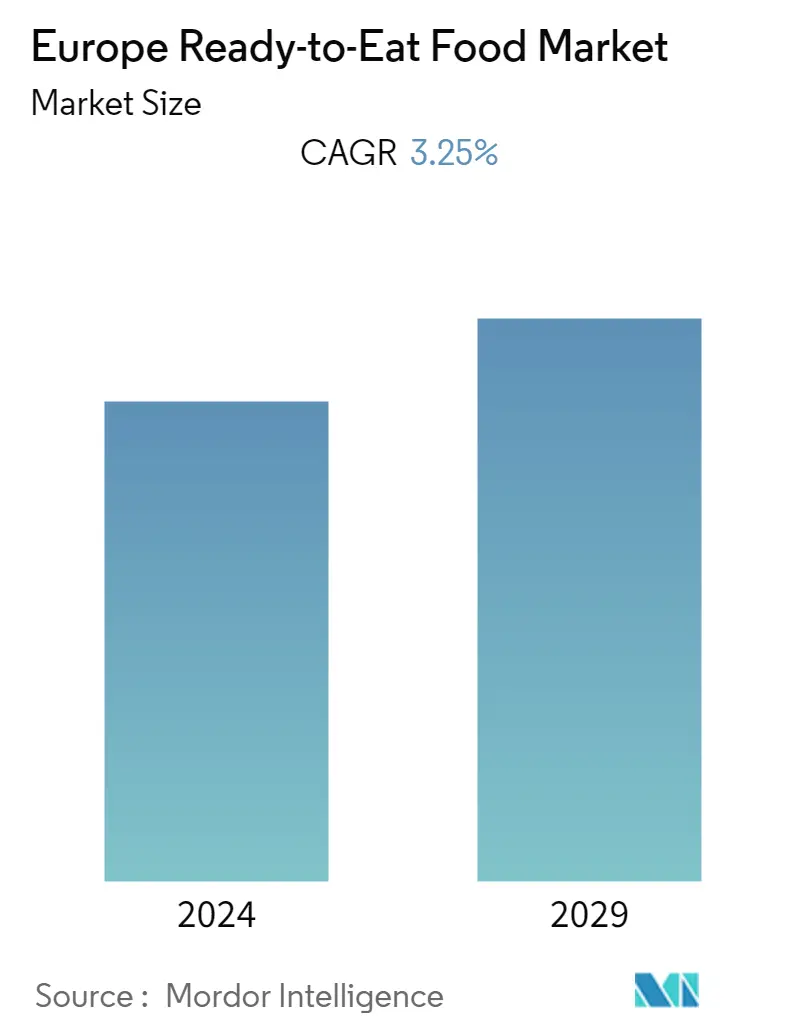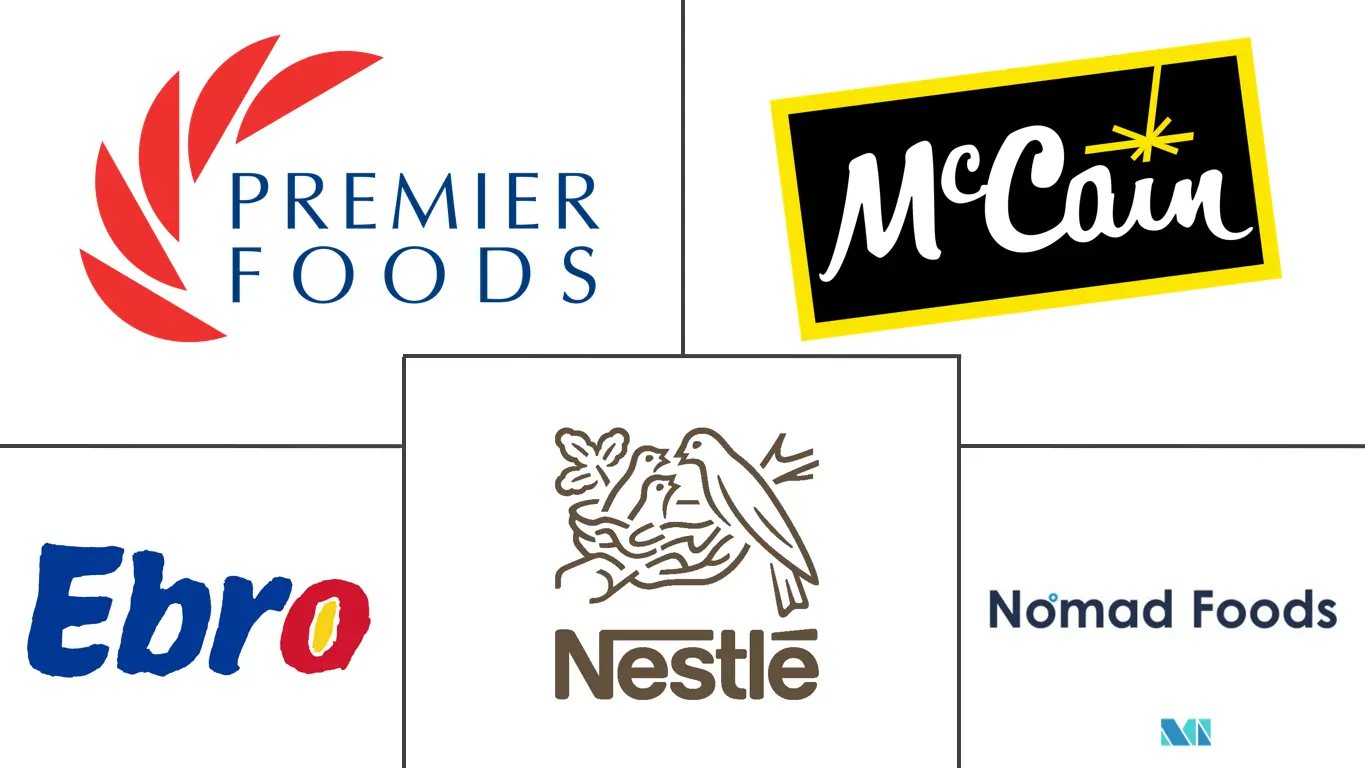Market Size of Europe Ready-to-Eat Food Industry

| Study Period | 2019 - 2029 |
| Base Year For Estimation | 2023 |
| Forecast Data Period | 2024 - 2029 |
| Historical Data Period | 2019 - 2022 |
| CAGR | 3.25 % |
| Market Concentration | Low |
Major Players
*Disclaimer: Major Players sorted in no particular order |
Europe Ready-to-Eat Food Market Analysis
The Europe Ready-to-Eat Food Market size is expected to grow from USD 85.65 billion in 2023 to USD 100.50 billion by 2028, at a CAGR of 3.25% during the forecast period (2023-2028).
- The growth of the ready-to-eat food market is driven by an increase in the convenience offered in terms of time-saving and efforts required to prepare these meals. Moreover, due to changes in social and economic patterns, increased spending on food and drink, increased awareness of healthy foods, changes in meal patterns and existing eating habits, an increase in the number of ex-pats settling across the region, and the desire to try new products, the demand for convenient and instant food, in particular instant pasta, rice, snacks, meat products, and others, is growing at a faster rate.
- For instance, the UK National Statistics Office (NSO) has revealed that about 9.6 million of the non-UK population resides in the United Kingdom. This ex-pat population in the country is constantly increasing with increasing migrations from other countries.
- Additionally, ethnic foods have been dubbed "cultural ambassadors," and ready-made ethnic dinners are becoming common in every store aisle. Since these cuisines have had significant market penetration over the past decade, the ready-to-eat ethnic food sector is more likely to rely on the fusion of ethnic blends in the region.
- Young consumers are spending most of their income on convenient ready-to-eat food products. Consumers between the ages of 20 and 30 are the easiest targets for ready-to-eat food manufacturing giants. This is because these consumers are primarily working professionals and college students who need help cooking at home due to their busy schedules. The convenience level of such products helps increase the total demand in the market across the region.
Europe Ready-to-Eat Food Industry Segmentation
Ready-to-eat foods are pre-cooked, pre-cleaned, mostly packaged, and ready for consumption without prior preparation or cooking. They are highly preferred for the convenience they offer.
The European ready-to-eat food market is segmented into type, distribution channel, and geography. Based on type, the market is segmented into instant breakfast/cereals, instant soups frozen snacks, meat snacks, ready meals, and instant noodles. Based on distribution channels, the market is segmented into hypermarkets/supermarkets, convenience stores/grocery stores, online retail stores, and other distribution channels. The report gives a detailed analysis of emerging economies in the European region, namely the United Kingdom, Germany, Spain, France, Italy, Russia, and the Rest of Europe.
For each segment, the market sizing and forecasts have been done on the basis of value (in USD million).
| Type | |
| Instant Breakfast/Cereals | |
| Instant Soups | |
| Frozen snacks | |
| Meat snacks | |
| Ready Meals | |
| Instant noodles |
| Distribution Channel | |
| Hypermarkets/Supermarkets | |
| Convenience Stores/Grocery stores | |
| Online Retail Stores | |
| Other Distribution Channels |
| Geography | |
| United Kingdom | |
| Germany | |
| Spain | |
| France | |
| Italy | |
| Russia | |
| Rest of Europe |
Europe Ready-to-Eat Food Market Size Summary
The European ready-to-eat food market is experiencing significant growth, driven by the increasing demand for convenience and time-saving meal options. This trend is largely attributed to changing social and economic patterns, such as a rise in food spending, heightened awareness of healthy eating, and evolving meal habits. The influx of expatriates and the desire to explore new culinary experiences have further fueled the demand for instant foods like pasta, rice, snacks, and meat products. Ethnic foods, often referred to as "cultural ambassadors," are becoming more prevalent, with ready-made ethnic dinners gaining traction across the region. Young consumers, particularly those aged 20 to 30, are a key demographic, as their busy lifestyles as working professionals and students make ready-to-eat options increasingly appealing.
The market is also witnessing a surge in plant-based and organic ready-to-eat products, reflecting the growing trend of veganism and health-conscious eating. The European region leads in frozen food consumption, with innovations in sugar-free and low-calorie options attracting health-conscious consumers. The convenience of microwaveable frozen meals is contributing to their popularity, as they require less effort compared to traditional cooking. Major players in the market, such as McCain Foods, Nomad Foods, and Nestlé SA, are focusing on product innovation and strategic partnerships to enhance their offerings and maintain competitive advantage. The emphasis on packaging quality and product innovation is intensifying competition, as companies strive to meet evolving consumer preferences and maintain market share.
Europe Ready-to-Eat Food Market Size - Table of Contents
-
1. MARKET DYNAMICS
-
1.1 Market Drivers
-
1.2 Market Restraints
-
1.3 Porter's Five Forces Analysis
-
1.3.1 Threat of New Entrants
-
1.3.2 Bargaining Power of Buyers/Consumers
-
1.3.3 Bargaining Power of Suppliers
-
1.3.4 Threat of Substitute Products
-
1.3.5 Intensity of Competitive Rivalry
-
-
-
2. MARKET SEGMENTATION
-
2.1 Type
-
2.1.1 Instant Breakfast/Cereals
-
2.1.2 Instant Soups
-
2.1.3 Frozen snacks
-
2.1.4 Meat snacks
-
2.1.5 Ready Meals
-
2.1.6 Instant noodles
-
-
2.2 Distribution Channel
-
2.2.1 Hypermarkets/Supermarkets
-
2.2.2 Convenience Stores/Grocery stores
-
2.2.3 Online Retail Stores
-
2.2.4 Other Distribution Channels
-
-
2.3 Geography
-
2.3.1 United Kingdom
-
2.3.2 Germany
-
2.3.3 Spain
-
2.3.4 France
-
2.3.5 Italy
-
2.3.6 Russia
-
2.3.7 Rest of Europe
-
-
Europe Ready-to-Eat Food Market Size FAQs
What is the current Europe Ready-to-Eat Food Market size?
The Europe Ready-to-Eat Food Market is projected to register a CAGR of 3.25% during the forecast period (2024-2029)
Who are the key players in Europe Ready-to-Eat Food Market?
Premier Foods Group Limited, McCain Foods Limited, Nestlé S.A., Nomad Foods Ltd and Ebro Foods, S.A. are the major companies operating in the Europe Ready-to-Eat Food Market.

